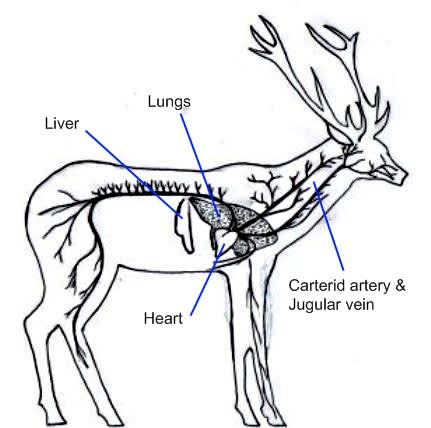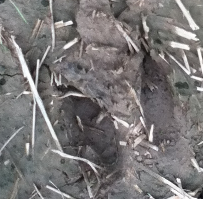10 Essential Skills for Bowhunters
In Search of Whitetails 09.20.12

Bowhunting is a challenging sport that has seen a surge of popularity in recent years. New equipment, such as lightweight compound bows, have made it accessible to those who might not be able to draw a recurve with sufficient power to hunt large game. Technological advances and gadgetry have also brought archery shooting to a more precise art. Just look at the bows that were used in the archery competitions at the Olympic games.
That said, a bowhunter needs many skills to pursue and take mature deer and/or turkey. I’ve chosen ten essential skills for the modern bowhunter, which fall loosely under scouting, woodcraft, or hunting/conservation. I don’t claim to be an expert at all of these, but I know them to be necessary. And since we live in the digital age, most can be learned from books, hunting blogs, informational web sites, and even YouTube videos.
Scouting Skills
A bowhunter needs to be able to locate the game. Usually, this is done by scouting: expeditions into the woods to learn the landscape, search for signs of animals, and look for likely places to set up a tree stand or blind.
1. Find and recognize animal sign.

The best way to locate our quarry in the woods is by what they leave behind. For whitetail deer and turkey hunting, these include:
- Animal tracks. These are usually left in mud or soft ground, so an excellent time to look for them is after recent rain or snow. An excellent place to look is near water sources. You should not only be able to recognize deer and turkey tracks, but also the marks of other animals that share the woods with them, especially predators like coyotes and mountain lions. The Missouri Department of Conservation provides an excellent guide called Animal Autographs (pdf) which includes, among other things, how to tell the tracks from a dog apart from a mountain lion.
- Droppings. Animal excrement is a sure sign of their presence in the woods. Deer droppings are usually the easiest to recognize. Turkey droppings often tell you the sex of the bird. Finding these, and checking them for “freshness” (for lack of a better word) is important to understanding the behavior of the target animals.
- Feathers. When scouting for turkeys, feathers are one of the most common signs you’ll come across. Breast feathers tell you the sex of the turkey (black tips for gobblers, brown for hens). Wing feathers on the ground may indicate scuffles between males, or (as I recently discovered while bowhunting for turkeys), roosting areas. The Arkansas Game & Fish Commission website has a nice section on determining the age and sex of turkeys.
- Scrapes and rubs. Whitetail deer are renowned for two more signs of their activity – scrapes, which are pawed-up patches of earth, and rubs, which are saplings rubbed/chafed by bucks (to get the velvet off of their antlers). Both of these are marked with gland scents of the whitetail; it’s my understanding they’re a kind of territory marker.
2. Understand deer and turkey biology.

The animals we pursue are generally driven by basic needs, the four S’s: shelter, sustenance, survival, and sex.
- Shelter, for much of the year, is where they sleep: roosting areas for turkeys, bedding areas for deer.
- Sustenance includes food, water, and other required minerals (such as salt, which deer seem to require).
- Survival means avoiding predators, and that includes us.
- Sex is dependent on finding “breeding” members of the opposite gender, and impressing them.
Of these four basic needs, sex is the one that many hunters try the hardest to exploit: it’s a fundamental weak point in all animals. That’s why we hunt the rut, practice turkey calls, put out hen-and-jake decoy sets, and coat things with doe urine. The need to procreate often prevails over an animal’s innate fear and wariness, especially among males. That makes them vulnerable.
3. Use topo maps, Google Earth, and GPS.
Basic navigation in the woods, including the use of maps and GPS, is a critical and potentially life-saving skill for the bowhunter. There’s a large conservation area near my home called Howell Island, a favorite haunt of bowhunters in the fall. Though mostly flat landscape, it’s heavily wooded and also well-covered by a dense, bamboo-like grass we refer to as “cane.” Hunters have gotten lost in this area and had to spend the night there. I’ve become disoriented myself, which is why I always, always bring a GPS.
All hunters should be able to read topographic maps (topo maps) and use them to prepare for hunting/scouting. This is a classic piece of advice for deer hunters, one preached by my favorite hunter-author, J. Wayne Fears. I’d expand on it to say that bowhunters should be familiar with (and make use of) Google Earth’s satellite imagery. It’s incredibly useful to get the “sky view” of the land where you plan to hunt. In the Missouri Whitetails forums, bowhunters often post a Google Earth image of their hunting grounds, and ask others to suggest potential stand sites. It’s an excellent way to gather and discuss intel on a new hunting location.
When I’m scouting, I take my GPS with me and note the locations of any sign, possible stand sites, and deer or turkey sightings. When I’m back home, I save those waypoints in Google Earth and make notes on them. Compiling information like this will help plan future hunts.
Woodsmanship Skills
Part of becoming a successful bowhunter is what I call woodsmanship, the practice of knowing how to handle yourself in the woods. These are skills that anyone can learn; they only require a bit of time, research, and practice.
4. Identify important plants and wildlife.
The forest is alive with many things other than the hunter and his prey: insects, reptiles, plants, trees, fungi, and other organisms are all part of the ecosystem. It’s probably not necessary to identify every living thing that you might encounter, but here are some big ones to know before you go out:
- Poison ivy and other toxic plants. You’ve probably heard the old adage “Leaves of three, let it be” referring to poison ivy and poison oak. Contact with these and other dangerous plants could ruin an entire hunting season. Learn what they look like. Avoid them whenever possible. Wear long pants, long sleeves, and gloves. And wash or sanitize everything when you come out of the woods to remove any oils. Oil can be transferred to other parts of the body or to other people days after the initial exposure.
- Things that bite or sting. Mosquitoes and ticks can carry a host of nasty diseases. Use high-DEET insect repellent to keep them away in early season. Also be sure you know about any venomous snakes or other poisonous critters you might encounter.
- Food sources. Here’s something you need not avoid, but might want to seek out: the plants and other food sources that whitetail deer and turkey depend upon for food. Part of woodsmanship is knowing which plants are eaten, when they’re eaten, and where to find them in the forest. Being able to distinguish between red and white oak trees/acorns, for example, is important for deer hunting in the Midwest, where such “hard mast” is a cornerstone of the whitetail’s diet.
5. Move quietly through the woods.
This may be one of the hardest skills to learn, and yet it’s fundamental for bowhunters: the ability to move through dense timber while making as little sound as possible. If you’ve ever been in a tree stand and heard a hunter walking through the woods, you know that we’re the biggest, loudest thing out there. The more you can minimize sound and visibility while going to or from your hunting spot, while scouting, or while stalk hunting, the better your odds will be.
How does one learn to sneak through the woods? Here are a few ideas to get you started:
- Avoid stepping on dry twigs or branches that will snap.
- Walk around obstacles (such as fallen trees) instead of over or through them
- Plan your travel timing and route. Leaves wet with rain or dew are quieter to walk upon. Dirt and mud are better than rocks or gravel.
- Muffle your gear. Nothing is more human or out-of-place in the woods than the clank of metal. Lash down loose gear, pad things with soft cloth, and secure any source of noise in your pack (e.g. climbing steps) or pockets (e.g. turkey call).
- Use cover noise. A gust of wind, a chittering squirrel, or even low-flying aircraft can offer cover noise to mask your movements. Wait for and exploit these opportunities.
Archery and Bow Skills
Archery is a key element of bowhunting, and taking a deer or turkey directly relies on the hunter’s competence in these basic archery skills.
6. Shoot accurately and consistently.
Many friends have asked me how well one must shoot a bow in order to hunt with one. My answer is that being able to shoot a pie plate 20 and 30 yards is good enough, as long as you can do it consistently. Most deer and turkeys taken by archery methods are shot at that distance. Your arrows should be in nice, tight groups at those distances; if they’re not then there’s a mechanical or methodological problem.
Bowhunters make every single shot count, even at the range. In the woods you’ll probably get one shot for dozens of hours of hunting.
7. Estimate distance in the woods.

If a bowhunter’s pins are precisely set, and he or she can hit the bullseye at any distance from 10 to 50 yards, that’s great. It’s also useless without the ability to measure or accurately estimate yardage while hunting. Learning to correctly estimate distance, and using that information to aim a shot correctly, is one of the most difficult aspects of bowhunting. It’s something I still struggle with and try to improve upon whenever possible. When I’m at the range, at a given distance, I ask myself, “How far away is the target? How would it look if it were a deer or turkey?”
In a pinch, I use this system to relate distances: 20 yards is about as far as I can wind up and throw a wiffle ball. I can throw a baseball about 30 yards without winding up, or 40 yards winding up. With a hop and an outfielder-style throw, I can throw a baseball about 50 yards. This works for me because it’s a system that uses familiar distances to estimate real ones.
There are at least two strategies for estimating yardage for a shot with higher accuracy. One is to measure out, and mark, distances from the blind or tree stand. Bright pieces of tape can serve as markers; so can turkey decoys. The other method, and probably the most accurate of all, is to bring a laser rangefinder out with you. These tend to be expensive ($150-200), but they deliver precision.
8. Shoot to kill.

Shooting and killing game with bow and arrow is fundamentally different from doing so with firearms. Rifles and shotguns usually kill with impact, meaning that the force of the bullet or shotgun blast is fatal. Arrows shot from a bow, in contrast, must kill by cutting. Whatever their intended game, bowhunters must know where to deliver a shot for it to be fatal. Both angle and location are important. For whitetail deer, the optimal shot is from broadside, through both lungs and heart. If not broadside, a deer that’s quartering away can be killed. A deer quartering toward or facing the hunter, however, is difficult to kill because vital organs are better protected.
There’s a great Outdoor Hub article on when to take your shot while bowhunting.
I admit I’m less of an expert in turkey anatomy, but I know this much: with a shotgun, you aim for the head and neck. With a bow, you aim for the body where it’s joined by the wing. Choice of broadhead and draw weight can influence success; I’ve read that using a knock-down tip instead of a bladed broadhead is advantageous, because the latter will often fly right through the bird and allow it to fly away.
If the animal is beyond a confident shooting distance, even if I have a pin for it, I won’t take the risk of maiming an animal. An injured animal could be tracked for hours, never found, and suffer quiet a bit. True bowhunters try for a quick, clean kill.
Hunting and Conservation Skills
Last, there are some elements of the pursuit and taking of whitetail deer and turkey that bowhunters will ultimately need to master. There are books written about these topics, so I’ll cover just two.
9. Deceive and ambush.
With an effective range of 20-30 yards, it is nearly impossible to stalk hunt whitetail deer or turkey with a bow. Believe me, I’ve tried. It can be done, but setting an ambush and bringing the game to you is far more likely to bring success. For any game, this means first identifying where those animals are and their daily/nightly patterns. Then, it’s about choosing an ideal ambush location:
- For deer, hunt the wind. Find a food source, bedding area, or travel route between the two where you can set up downwind. Natural funnels and squeeze points created by geography are also effective ambush locations. Rattling, grunting, doe bleat calls, and estrus lures are all options for luring deer into your shooting zone. Learn about these tools and master them before you depend on them in the field.
- For turkeys, hunt from concealment. Nine times out of ten, turkeys see or hear a hunter before coming into shooting range. Good concealment, keeping absolutely still, and using decoys to keep the birds’ attention will help keep the hunter from being “busted.” Perhaps the most important skill in turkey hunting, however, is learning to call the birds in. There are many good books, recordings, and videos that teach this.
10. Track, recover, and field dress game.
When the shot is taken, the hunt may be over, but the work is not. Often fatally-wounded animals will run or fly away, sometimes for hundreds of yards. A bowhunter is obligated to make a diligent effort to track and recover anything he or she shoots. This usually means following a blood trail. When the game is recovered, after ensuring that it’s dead, the hunter must properly field dress it. Field dressing a deer or plucking a turkey may be the unpleasant side of bowhunting, but they’re necessary to properly harvest and preserve the meat. There’s more than one way to go about it; find something that’s comfortable. For example, you can skin rather than pluck a turkey.
The bowhunter that field dresses game taken by bow and arrow has likely learned most, if not all of these skills. As hunters, though, we can never stop improving, never stop honing our craft. And when we feel as if we can, it’s probably time to pass that knowledge on to the next generation of bowhunters.
This article was originally published on In Search of Whitetails and is republished with permission.


